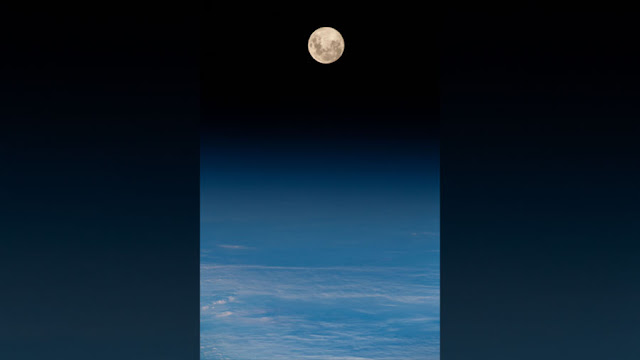ISS - Expedition 59 Mission patch.
May 21, 2019
The Expedition 59 crew is spending all day Tuesday exploring how astronauts adjust with Earth’s gravity no longer bearing down on them. Spacewalk preparations and lab maintenance are also ongoing aboard the International Space Station.
Station crewmembers and future astronauts going to the Moon in 2024 have to adjust to the lack of a sunrise/sunset cycle humans experience everyday on Earth. As a result, time perception is impacted and may affect sleep and work patterns. Astronauts Anne McClain, Nick Hague and David Saint-Jacques started the day on a study, going on since July 2017, exploring subjective changes in time that can alter physical and cognitive performance.
Image above: The full moon is pictured from the International Space Station as the orbiting complex orbited 263 miles above the South Atlantic Ocean. Image Credit: NASA.
Hague later sequenced DNA samples for a study exploring how increased exposure to space radiation impacts crew health. He used the Biomolecule Sequencer for the investigation to demonstrate DNA sequencing in space. The Genes In Space-6 experiment is researching how space radiation damages DNA and how the cell repair mechanism works in microgravity.
Immune system studies continued full speed ahead today to test the hypothesis the immune response decreases in space. Astronaut Christina Koch teamed up with McClain and Saint-Jacques throughout the day observing mice for the study. Observations may help scientists develop advanced vaccines and therapies benefiting both astronauts and Earthlings.
From Day Into Night on the International Space Station
Image above: NASA astronaut Christina Hammock Koch posted this image of Earth taken from aboard the International Space Station. She said: "A couple times a year, theInternational Space Stationorbit happens to align over the day/night shadow line on Earth. We are continuously in sunlight, never passing into Earth’s shadow from the Sun, and the Earth below us is always in dawn or dusk. Beautiful time to cloud watch. #nofilter". Image Credit: NASA.
Commander Oleg Kononenko continues to set up a pair of Russian Orlan spacesuits and outfit the Pirs airlock as the May 29 spacewalk approaches. Flight Engineer Alexey Ovchinin worked on space cardiology research before switching to space plumbing and pumping urine into the Progress 71 cargo craft.
Related links:
Expedition 59: https://www.nasa.gov/mission_pages/station/expeditions/expedition59/index.html
Time perception: https://www.nasa.gov/mission_pages/station/research/experiments/explorer/Investigation.html?#id=7504
Biomolecule Sequencer: https://www.nasa.gov/mission_pages/station/research/experiments/explorer/Investigation.html?#id=1917
Genes In Space-6: https://www.nasa.gov/mission_pages/station/research/experiments/explorer/Investigation.html?#id=7893
Immune system studies: https://www.nasa.gov/mission_pages/station/research/experiments/explorer/Investigation.html?#id=7868
Space cardiology research: https://www.energia.ru/en/iss/researches/human/11.html
Pirs airlock: https://www.nasa.gov/mission_pages/station/structure/elements/pirs-docking-compartment
Moon in 2024: https://www.nasa.gov/specials/moon2mars/
Space Station Research and Technology: https://www.nasa.gov/mission_pages/station/research/index.html
International Space Station (ISS): https://www.nasa.gov/mission_pages/station/main/index.html
Images (mentioned), Text, Credits: NASA/Mark Garcia.
Best regards, Orbiter.ch



